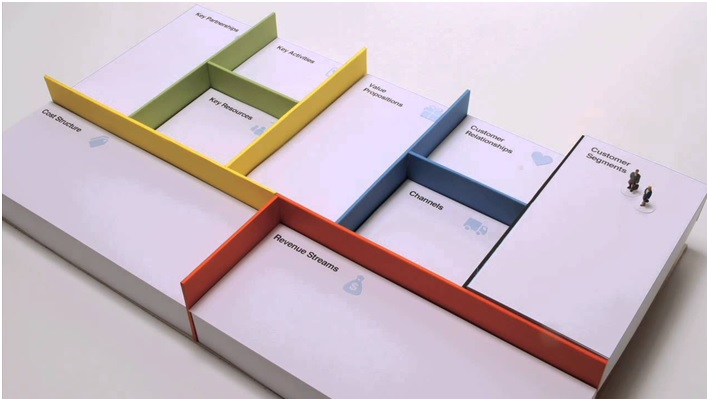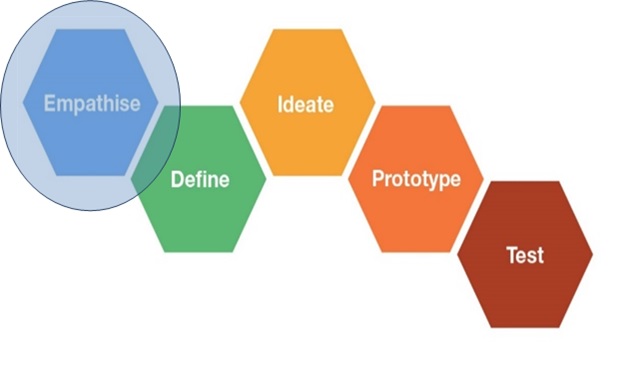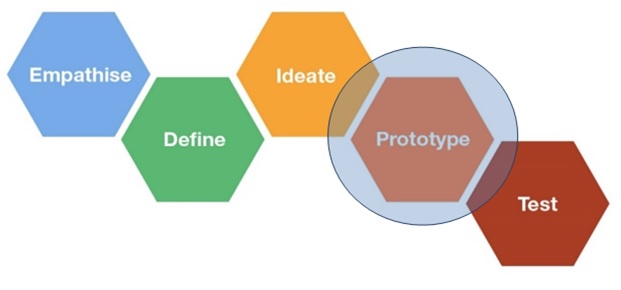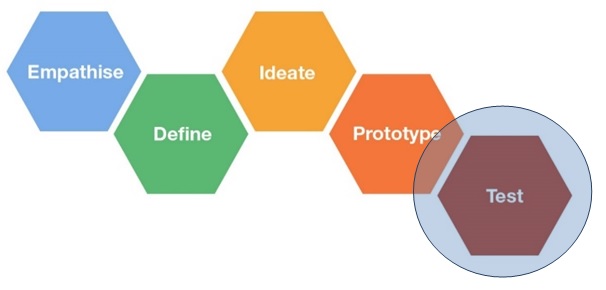USING DESIGN THINKING TO DESIGN BUSINESS MODELS
February 24, 2016
In this second article of the Enterprise Architecture for Business Model Innovation Series, a design think-based approach is presented for business model design. Design thinking is a user-centered design philosophy based on building empathy to guide the search for breakthrough innovation. The design process involves the innovation team introduced in the first part of the series.
Business Model Design
Business model design sets out to define how an enterprise creates, delivers and captures market value. The interrelationship between those three facets is key to understanding how a business model can be invented to define a new venture. Intrapreneurs exercise the ideation component to produce novel products or services to potentially create a new market with a compelling value proposition for target customer segments. The activities and processes that need to be executed together with partners and suppliers to ship the product or service to customers define the value fulfillment mechanism. Lastly, the enterprise captures value when customers pay for the product or service contributing to the revenue stream. Implementing this value generation cycle is the essence of business model design.
Business Model Canvas
A valuable tool to use for prototyping a business model is the more–>Business Model Canvas. The Business Model Canvas is a strategic management asset to describe, design, and invent business models using an ontology developed by Alexander Osterwalder2. The Business Model Canvas provides a visual representation for the main aspects that define how an enterprise creates, delivers and captures value.
The canvas can be developed using paper prototyping techniques where each of the elements are represented by note cards and modified easily during the design process3. The tactile nature of this technique induces collaboration and intense feedback to establish a shared vision for the innovation in business model design. Alternatively, the Business Model Toolbox is an iPad application available in the Apple AppStore to develop the aspects of the Business Model Canvas in digital form.

Value Propositions
On the Business Model Canvas, Value Propositions are the product or service that will offer value to customers based on novelty, performance, risk reduction, cost efficiencies, customization, or other desired outcomes. Essentially, these are the reasons customers will pay for an enterprise’s offering that solves a problem or satisfies a particular need and serve as the basis for Revenue Streams.
Customer Segments
Customer Segments identify the target market which realize benefits from Value Propositions that are specifically designed that intended audience. Each segment will have a corresponding level of profitability so it is important to understand how this impacts the business model design.
Customer Relationships
Customer Relationships define the nature of the ongoing engagement between the enterprise and customers. They define the frequency of interaction as well as the mechanisms by which customers will derive value from doing business with the enterprise.
Channels
Channels are the distribution modes by which demand for products and services is generated in target Customer Segments as well as how fulfillment is delivered.
Revenue Streams
Revenue Streams capture the options and mechanisms by which Customer Segments pay for products and services. Options may include flat fees, subscription models or auctions. Payment mechanisms may involve online portals, mobile applications, or retail locations.
Key Activities
Key Activities are the business processes and operations required to support the business model. These processes may involve partners, suppliers and alliances to deliver the value to customers. Operations include platform capabilities required to support the data and interfaces to enable the collaboration between these organizations as well as customer-facing channels.
Key Resources
Key Resources are the physical and digital assets used to provide capability for the various components in the business model. Resources needed to fulfill demands in Key Activities, Channels, Customer Relationships and Revenue Streams should be considered to ensure value is created, delivered, and captured efficiently. The resources may involve intellectual property, financial instruments, and human capital.
Key Partners
Key Partners indicate suppliers, service providers, and alliances that support Key Activities and Key Resources to deliver on the Value Proposition to Customer Segments.
Cost Structure
The Cost Structure describes the fixed and variable expenditures required to support Key Activities and Key Resources. It is important to consider whether the business model is cost or value driven. A cost-driven business model is more concerned with efficiencies such as automation and price-based value proposition. A value-driven business model is focused on maximum value creation offered by a premium value proposition.
Design Process
Starting a new venture within the enterprise for business model innovation begins with a mobilization of team consisting of intrapreneurs, enterprise architects and executives from existing business units. Executives from these business units work together with enterprise architects to identify shared services and data that would support the new ventures. Intrapreneurs initiate the ideation activities to identify possibilities for new value propositions for Customer Segments.
The team next seeks to understand the viability of the value propositions by conduct market research and identifying how they can take shape with new products and services. These activities require the team to analyze customer contexts and feedback to gain a deep understanding of the needs and problems that present an opportunity. This particular part of the design is covered in greater detail in the next section.
In the design phase, the elements of the business model are discussed and defined with the innovation team. Business model prototyping is the key activity to experiment with various designs on the Business Model Canvas. The team can use post-it notes on a wall in the design room to rapidly change the elements in the Business Model Canvas. Different versions of proposed business model prototypes can be evaluated to determine best fit and optimal viability for the target Customer Segments. Other factors such as Key Resources and Key Activities can be assessed to support Channels, Customer Relationships, and Revenue Streams. The deliverable from this design phase is a Business Model Canvas that has been selected with the highest evaluation determined by the innovation team. In fact, it is in the design phase that enterprise architects begin the process of mapping the business model to an operating model. Enterprise architects collaborate with intrapreneurs to identify the data and processes to enable the elements in the business model.
A plan to deploy the selected Business Model Canvas is then developed to begin delivering the Value Propositions in the market. The plan should include a roadmap to keep Key Partners synchronized with the deployment timeline and to ensure dependencies will be met. Enterprise architects work with Key Partners to facilitate the integration of services and data to enable the processes in the new business model design. Intrapreneurs also begin working with Channels to drive demand for the offerings in the target Customer Segments.
Design Thinking for Business Model Design
Using design thinking to structure the process and philosophy guiding the business model innovation can produce breakthrough results. Design thinking is composed of several mindful spaces intended to drive generative production of ideas and insights while driving towards a focused value position all based on the initial empathy developed for the users. The value position is so compelling as to drive massive adoption by users, thereby creating significant market value.
In the Empathise space, the objective is to become immersed in the users’ world. The intrapreneurs will lead in this space. Some of the key steps that can be incorporated in this space include the following:
- Ask open questions to reflect any negativity on the user’s status quo.
- Ask open questions to reflect on any specific bad experiences the user may have gone through.
- Ask your user to act out the current experience. Observe any gaps, difficulties, or breakdowns.
- From user quotes and defining words, infer thoughts and beliefs.
- From user actions and behaviors, infer feelings and emotions.
- Fan out and expand the problem space by honing the questions being asked the user.
- Look for deeper signals from the market or community of users.
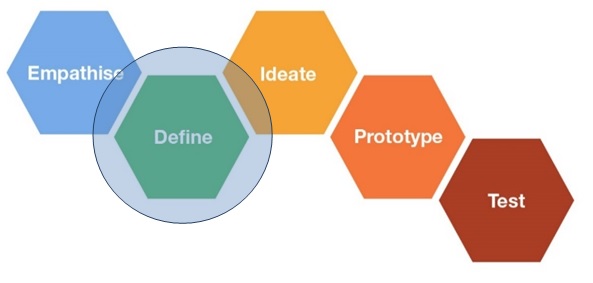
In the Define space, the objective is to reframe the problem space by identifying latent user needs or discovering novel insights. The intrapreneur working with designers will define a POV and value statement that contribute to the Value Proposition in the business model design. One way to think about this step is developing market fit. In this sense, the Customer Segments and Customer Relationships come into focus. Some of the key steps that can be incorporated in this space include the following:
- Explore what the apparent needs of the market or community of users.
- Explore what the latent, deeper needs of the market or community of users.
- Develop insights via inferences from the exploration.
- Look for emotional cues and signals.
- Zoom in and zoom out on the exploration from community to user, user to community.
- Change the perspective by reframing the initial problem set.
- Draw and sketch thumbnail visions to drive further design.
- Design the problem.
- Define the problem statement.
In the Ideate space, the objective is an intense generative production of possibilities to meet an existing or unrealized market need based on the problem statement. In this space, intrapreneurs collaborate with enterprise architects to determine what resources are available to deploy for the new product or service. Technology and partners will be key factors in this ideation as well as enterprise platforms. Key Activities, Key Resources, Key Partners, and Channels are defined in the ideation.
- In ideation, the first thing is to unlearn what you know.
- Be attentive and ready for new ideas.
- Brainstorm by storming preconceptions using inquiry that questions the status quo.
- Connect the dots.
- Connect ideas across existing solutions or enterprise services already deployed in the market.
- Connect ideas by associative log or analogy.
- Connect ideas by using stories, patterns of behavior useful to reach an outcome.
- Connect ideas leveraging synchronicity to create meaning for the user.
- Create focus and start to synthesize the new business model.
- Get feedback from executives and intended market or community of users.
In the Prototype space, the objective is to build to think. The emerging business model can be modeled using paper prototypes. The product or application delivering the value to the user can also be modeled paper prototyping. The intrapreneurs and enterprise architects can also build the prototype business model using the Business Model Toolbox application mentioned earlier. It is important to understand that there is a dual design process involved in creating the new business model based on the product or service that has been defined up to this point. It is also key to begin to define how the Cost Structure and Revenue Stream components in the business model are factored into the prototyping.
- In Prototyping it is key to build to think.
- Use role playing to prototype new behaviors.
- Use storyboarding to draw out new experiences.
- Draw and create paper prototypes of the product or application.
- Draw and create lo-fi mockups of new product or application.
- Prepare to test these paper cutouts with users to get feedback.
- Synthesize a breakthrough.
- Seek feedback from enterprise executives on the business model prototype.
- Align business model components with the product or service prototyping. Use the Business Model Toolbox application to capture refinements.
The Test space objective is to get market or user feedback on the new product or service. This set of activities also involve validating business model hypothesis based on that feedback. A critical component is to test out the Value Proposition such that Revenue Streams and Cost Structure factors in the prototype are validated. This is the crux of business model innovation – will the new product or service delight the user such that adoption will drive growth for the new venture?
- Build the prototype. Perhaps use a 3D printed model for testing if a product is involved.
- Test the prototype. If necessary, use cutout prototypes in early testing to refine the product.
- Gather feedback from the users.
- Track what delights the users. Are business model hypothesis being validated by the user?
- Track refinements suggested by the users. Be ready for the users to help you innovate!
- Collect the data. Analyze and improve the design.
- Visit any previous design thinking space as needed to refine the design until the product or service along with the corresponding business model is ready to be deployed as a new venture.
The output of the design thinking process are a new business model and a product or service that will deliver value to the market or community of users via the new venture. An operating model that is well-suited to the new business model characteristics can now be identified.
In the next part of the series, several classes of operating models will be introduced. A mapping strategy will be described to assist with the identification of the operating model based on the business model design.
References
- The Business Model Innovation Factory: How to Stay Relevant When the World is Changing, Saul Kaplan, Wiley Press, 2012
- Alexander Osterwalder (2004). The Business Model Ontology – A Proposition In A Design Science Approach. PhD thesis University of Lausanne.
- Business Model Generation, Alexander Osterwalder, Yves Pigneur, Wiley Press, 2010.
- Enterprise Architecture as Strategy: Creating a Foundation for Business Execution, J. Ross, P. Weill, D. Robertson, Harvard Business School Press, 2006.
- USAF Colonel John Boyd, briefings on military strategy. (http://en.wikipedia.org/wiki/OODA_loop)
- Reinventing Your Business Model, Clayton M. Christensen, Mark W. Johnson, Henning Kagermann, Harvard Business Review, December 2008.
- Creating Value Through Business Model Innovation, Raphael Amit, Christoph Zott, MIT Sloan Management Review, Spring 2012 Vol. 53 No. 3.
- 2012 IBM CEO Study, Leading Through Connections, IBM Corporation.
- Change by Design: How Design Thinking Transforms Organizations and Inspires Innovation, Tim Brown (IDEO CEO), HarperBusiness, 2009.
- The Storm of Creativity, Kyna Leski, MIT Press, 2015

 English | EN
English | EN 
